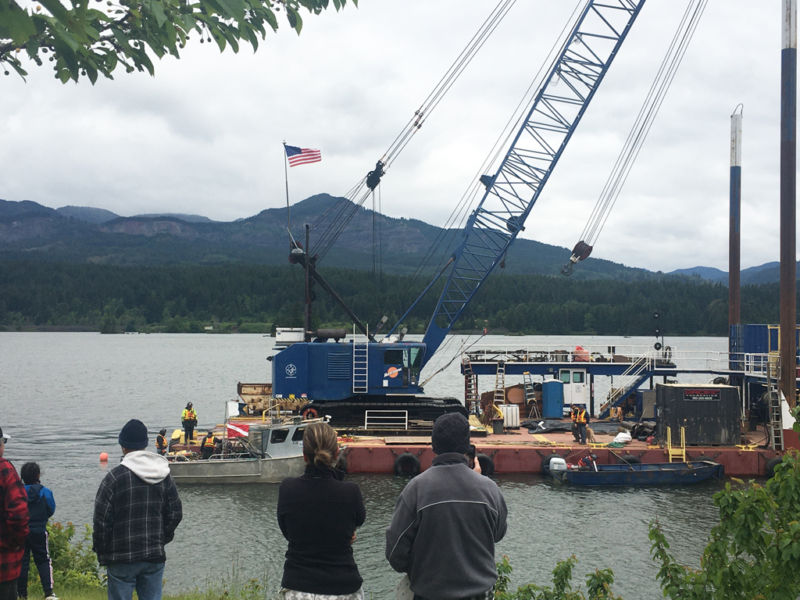Environmental impact deemed minor after a private plane ditched into the river at Cascade Locks
Chuck Thompson, May 23, 2020. On May 17, a single-engine Beechcraft Bonanza J35 airplane crashed into the Columbia River. The pilot and sole passenger managed to swim to safety, sustaining only minor injuries.
On May 23, the plane, which sunk after the accident, was removed from the river. It was hauled up near where it went down in front of the Port of Cascade Locks Marina on the Oregon side of the Columbia Gorge, less than a mile upriver from the Bridge of the Gods.
According to the Oregon Department of Environmental Quality, the plane was submerged in about 15 feet of water.
Using a barge and crane, the extraction effort was undertaken jointly by Advanced American Construction of Portland, and NU Venture Air Services of Dallas, Oregon.
The salvage, which took place less than 50 yards from shore and drew a small gathering on onlookers, got underway early Saturday morning. At about 10:15 a.m., a single diver entered the water to assess the aircraft and affix chains connected to a crane cable. Just after 11 a.m., the tail section broke the surface as the plane was slowly lifted out of the water.
The aircraft emerged in one piece. At 11:21 a.m. it was gently placed on the deck of the barge.
According to NU Venture Air Services owner Mike Dowd, the salvage operation went smoothly, with the removal crew encountering no unexpected obstacles.
“There is no run of the mill job, especially with something submerged,” said Dowd. “There’s never one that’s just routine. We plan and plan and try to account for any possibility.”
NU Venture Air Services has experience recovering aircraft in a variety of terrain and circumstances. In June 2019, it recovered a Maule M-7-235B seaplane that crashed into the Deschutes River in Sunriver, killing one.
Environmental impact light
According to Oregon DEQ, the United States Coast Guard reported the accident on May 17 through the Oregon Emergency Response System, estimating a potential spill of 4.87 gallons of aviation fuel. Intertribal police soon placed buoys around the crash scene to prevent accidents with other river traffic.
“Catch booms were put out right away after the crash,” said Sgt. Pete Hughes of the Hood River County Sheriff’s Office.
“Because there’s a low potential for release we don’t have responders out there,” Oregon DEQ spokesperson Laura Gleim told Columbia Insight on May 22. “There’s such a small potential for significant fuel release, it falls to the insurance company (to take care of).”

The salvage operation, which lasted about four hours, attracted a small group of onlookers. Photo by Chuck Thompson
Dowd said his company hadn’t been made aware of any environmental issues with the crash prior to beginning salvage operations.
No cause of the crash has been determined, though witnesses said the plane’s landing gear did not properly descend during its landing approach at the Cascade Locks Airfield.
With the aircraft now recovered, the National Transportation Safety Board (NTSB) will conduct an investigation.
“COVID-19 is slowing things down a bit,” said Southern California-based NTSB investigator Eliott Simpson, who is assigned to the case. “We have travel restrictions.”











I missed this piece till now. How did the OR DEQ estimate the remaining fuel in the plane’s tank(s) at 4.87 gallons? One possibility is that they drained the fuel from the sump, which is routinely used to check for water contamination.
The quantity of fuel raises a safety question. Did the pilot underestimate the fuel required for the route, including a missed approach or diversion?